Effect of idol immersion activities on the water quality of urban lakes in Bengaluru, Karnataka
1
ICAR-Central Soil Salinity Research Institute,
RRS Bharuch,
Gujarat,
India
2
Department of Agronomy,
Bidhan Chandra Krishi Viswavidyalaya,
Nadia,
West Bengal
India
Corresponding author Email: gorainbisweswar@gmail.com
DOI: http://dx.doi.org/10.12944/CWE.14.1.13
Copy the following to cite this article:
Gorain B, Paul S. Effect of idol immersion activities on the water quality of urban lakes in Bengaluru, Karnataka. Curr World Environ 2019;14(1).
DOI:http://dx.doi.org/10.12944/CWE.14.1.13Copy the following to cite this URL:
Gorain B, Paul S. Effect of idol immersion activities on the water quality of urban lakes in Bengaluru, Karnataka.Curr World Environ 2019;14(1). Available from: https://bit.ly/2Y8eelw
Download article (pdf)
Citation Manager
Publish History
Select type of program for download
| Endnote EndNote format (Mac & Win) | |
| Reference Manager Ris format (Win only) | |
| Procite Ris format (Win only) | |
| Medlars Format | |
| RefWorks Format RefWorks format (Mac & Win) | |
| BibTex Format BibTex format (Mac & Win) |
Article Publishing History
| Received: | 2019-01-29 |
|---|---|
| Accepted: | 2019-03-16 |
| Reviewed by: | 
 Akhilanand Chaurasia
Akhilanand Chaurasia
|
| Second Review by: |

 MOHD FUAT A RAZAK
MOHD FUAT A RAZAK
|
| Final Approval by: | Dr. Gopal Krishan |
Introduction
Urban lakes are inland aquatic systems supporting ecosystem through biodiversity sustenance and acts as a source of water in lean season. Recently, urban lakes are in the merge of extinction due to encroachments, siltation as well as eutrophication from domestic and industrial effluents.1 The lakes in Bengaluru are also facing similar problems as indicated by satellite images and information available with Survey of India.1,2 These are subjected to varying degrees of degradation and pollution. The water quality deterioration in the lakes is mainly due to the discharge of untreated or partially treated sewage, organic, inorganic and toxic pollutants of industrial and domestic origin. Immersion of painted idols as a part of religious activities is reported to be an important source of heavy metal contamination in the lake water.3,4,5
The principal components in paints include pigments, vehicles and solvents. Pigments are colour contributing insoluble solids, containing heavy metals as one of the main constituents. The major lead-containing pigments include red lead, leaded zinc oxide, white lead, chrome green, chrome yellow and chrome orange. Lead is present in these pigments as oxides, carbonates, hydroxides and chromates. Vehicles are the adhesives causing the pigment to adhere to a surface. They comprise of synthetic and phenolic resins. Solvents are used to adjust the consistency of the paint. Most commonly used solvents are naphtha, mineral spirits and turpentine. Generally, solvent-based paints contain25% binders, 27.5% pigment and 47.5% organic solvents.6 These paints are used for colouring idols of Lord Ganesha and Goddess Durga which are later immersed in the lakes as a part of religious rituals. Further, the addition of organic matter (leaves, flowers etc.), as a part of these activities, increases BOD and COD levels which in turn affect the aquatic environment adversely.7 Addition of Sindur in these water bodies(reported to contain lead and chromium) is very toxic to human beings even at very low concentrations.8
These heavy metals subsequently get adsorbed on the charged surfaces of silt and clay or simply get dissolved in lake water. These heavy metal-laden water and sediments, if used for irrigation or as an amendment, can be translocated in the plant parts and enter the human system through food chain. The transfer factors of metals in the plant system vary not only with soil properties (pH, Eh, moisture, microbial diversity, organic matter content etc.) but also with the physiology of the crop. The content of heavy metals in edible plants follows the order: leafy vegetables > root crops > fruits. It was reported that the use of contaminated lake water for irrigation purpose has not only contaminated the vegetables and cereals but also animal milk.9 Regular ingestion of heavy metal contaminated food and water cause biomagnifications in human and animal systems and may adversely affect the normal physiological functions. In this context, a study was conducted with the objective of determining the effect of idol immersion activities on heavy metals contamination and lake water quality.
Methodology
Location of the lakes
Nagavara lake (13°02'N, 77°36'E) is one of the popular attractions of Bengaluru. The lake is situated in the outer ring road of Bengaluru and is spread across an area of 43.86 hectares. Ulsoor lake (120 58’ N, 770 37’E) is located in central Bengaluru and begins roughly near the eastern terminus of MG Road. The lake has a catchment area of 1.5 km2 fed by three drains at different locations. The surface area of the lake is 50 ha. These lakes are located in densely populated areas with possible chances of heavy metals contamination. Since they had the potential to cater to the water demand of the locality in the lean season through the conservation of a large volume of water, these lakes were selected for the study.
Sampling of lake water and analysis
Water samples were collected from five randomly selected points within 20-30 feet from the immersion sites of two different lakes of Bengaluru viz. Nagavara and Ulsoor, 30 days before immersion activities (T1) and thereafter periodically at 1 (T2), 7 (T3), 14 (T4), 30 (T5) and 45 (T6) days. The water samples were analysed for physicochemical parameters viz. pH, EC, chemical constituents e.g. alkaline and alkali earth elements viz. Ca, Mg, K, Na and heavy metals viz. Fe, Pb, Cd and Cr. The analysis of physicochemical properties and estimation of the dissolved metal content were done after filtering the water samples (500 mL) using What man No 41 filter paper (0.45 µm pore size). The filtrates were preserved with 2 ml nitric acid to prevent the precipitation of metals. The samples were then concentrated on a water bath and subjected to nitric acid digestion prior to the estimation of metals using Atomic Absorption Spectrophotometer (Perkin Elmer Analyst, 700). The physicochemical and biochemical water quality parameters were analysed using standard procedures.10,11,12 The observed data were sere analyzed for the measures of central tendency (mean) and measures of dispersion (standard deviation).
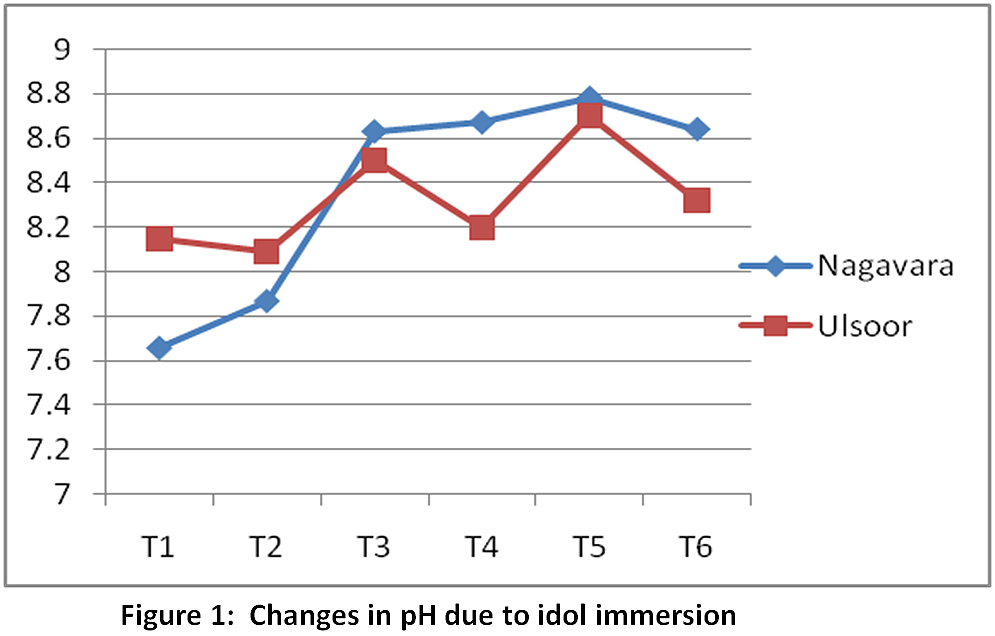 |
Figure 1: Changes in pH due to idol immersion Click here to view Figure |
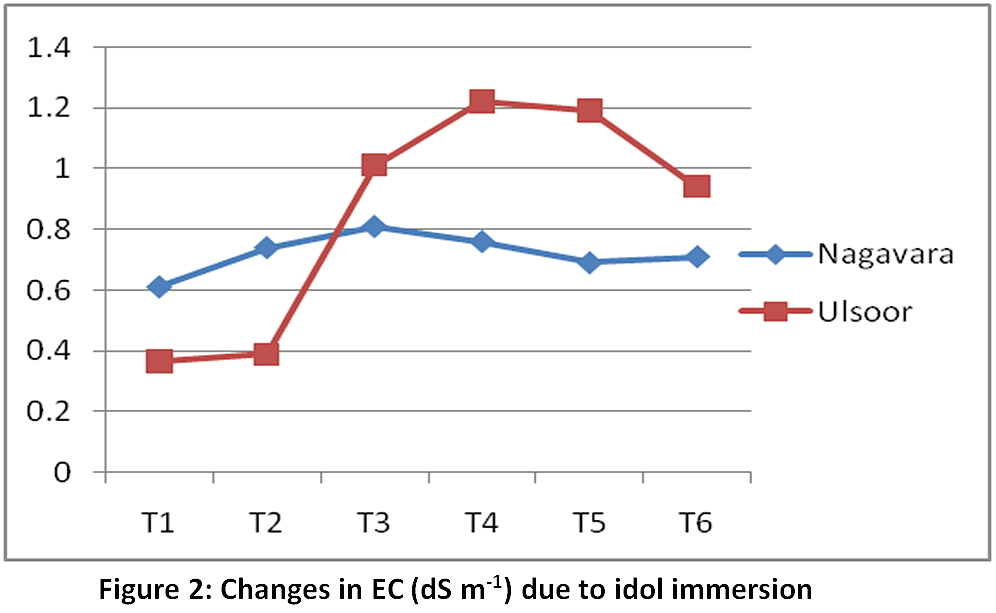 |
Figure 2: Changes in EC (dS m-1) due to idol immersion Click here to view Figure |
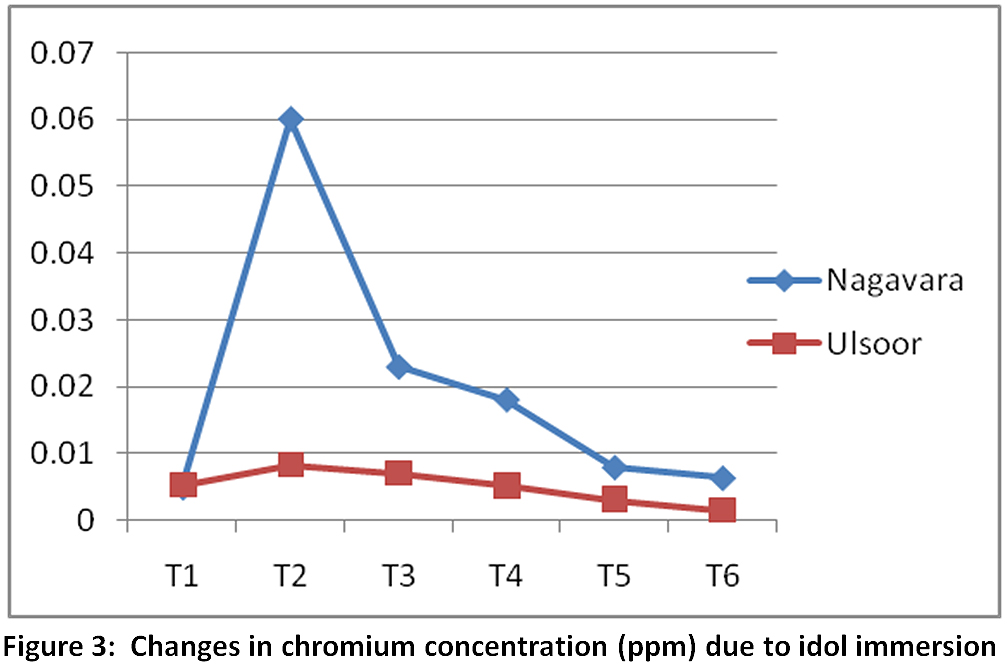 |
Figure 3: Changes in chromium concentration (ppm) due to idol immersion Click here to view Figure |
Results and Discussions
Changes in physicochemical properties of lake water due to idol immersion
The EC of the Ulsoor lake water had increased from 0.36 dSm-1 before immersion to 1.22 dSm-1 after 14 days of immersion (Fig. 2). The pH of the water increased from 8.15 to8.7, 30 days after immersion with a standard deviation of 0.23 (Fig. 1). The EC of Nagavara lake water increased from 0.61 dSm-1 to 0.81 dSm-1 seven days after immersion. The average EC observed in the course of the study was 0.72 dSm-1 with a standard deviation of 0.06dSm-1 (Fig.2). The pH of the water increased from 7.66 to 8.78 at 30th day after immersion with a standard deviation of 0.48(Fig. 1). The increase in EC of the lake waters (Fig. 1) in the post-immersion period might be attributed to the incorporation of various salts during the immersion activities. Similar results were recorded in the Hebbal and Bellandur lakes of Bengaluru.13 The difference in the mean electrical conductivity (EC) of the lake waters is a function of the degree of salt inclusion through sewage, sludge, domestic effluents and monsoonal runoff from adjoining agricultural fields along with the extent of idol immersion.14,15,16 The decrease in pH was might be due to the decomposition of organic matter added during the idol immersion as well as from other domestic and industrial sources. The mechanism of pH reduction can be described by the following equations:
R-COOH → R-COO- + H+ (Eq. 1)
R-OH → R-O- + H+ (Eq. 2) [R- aliphatic or aromatic moiety]
Contamination of lake waters with heavy metals and other inorganic ions
In Ulsoor lake, the nitrate content of water before immersion was 1.51 ppm which increased to 4.7 ppm after 14 days of immersion (Fig. 7). The concentration of Ca recorded, 30days after immersion was 11.51meql-1 and the mean was 7.66meql-1. The average concentration of Mg, K and Na followed similar trends (Table 1). Higher BOD and COD values were recorded in lake water seven days after immersion activities. Due to the immersion of painted idols, the changes observed in the metal content of Ulsoor lake water are presented in Fig. 3, 4, 5 and 6. The mean concentration of Fe recorded was 2.82 ppm with corresponding standard deviation of1.38 ppm, respectively. The Pb content was recorded to be 0.0016 ppm before immersion which increased to 0.0062 ppm 30 days after immersion. However, the mean Pb concentration of the lake water during the entire course of the study was 0.003 ppm with a standard deviation of 0.001 ppm. A similar trend in the increase in the concentration ofCr, Ni and Cd were also observed. The average concentration of Cr and Cd in the lake was 0.005 and 0.002 ppm respectively (Fig 3 and 4).
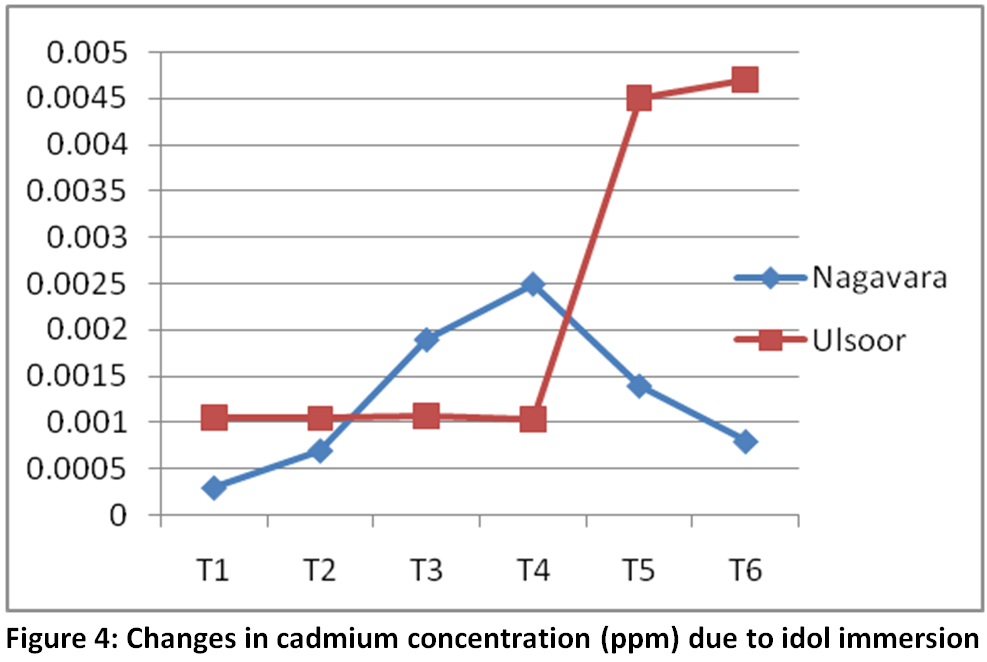 |
Figure 4: Changes in cadmium concentration (ppm) due to idol immersion Click here to view Figure |
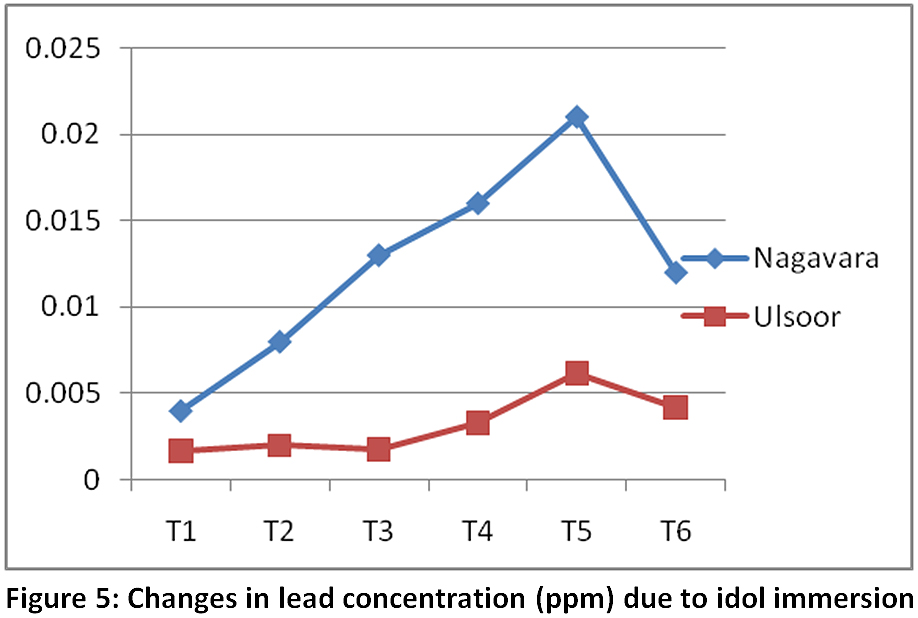 |
Figure 5: Changes in lead concentration (ppm) due to idol immersion Click here to view Figure |
Table 1: Alkali and alkaline earth metals concentrations in Ulsoor lake water before and at different intervals after immersion of idols
| Period of sampling | Ca | Mg | K | Na |
| (meqL-1) | (ppm) | |||
| T1 | 3.5 | 1.8 | 28.5 | 19.1 |
| T2 | 4.7 | 1.6 | 35.3 | 21.5 |
| T3 | 9.63 | 3.2 | 36 | 26.2 |
| T4 | 7.33 | 2.8 | 33.5 | 27.5 |
| T5 | 11.51 | 3.6 | 29 | 23.75 |
| T6 | 9.33 | 3.4 | 28.4 | 22.5 |
| mean | 7.66 | 2.73 | 31.78 | 23.42 |
| S.D. | 3.08 | 0.84 | 3.55 | 3.08 |
T1: sampling before 30 days, T2, T3, T4, T5 and T6: sampling 1, 7, 14, 30 and 45 days after idol immersion activities, respectively
Table 2: Alkali and alkaline earth metals concentrations inNagavara lake water before and at different intervals after immersion of idols
| Period of sampling | Ca | Mg | K | Na |
| (meq l-1) | (ppm) | |||
| T1 | 4.6 | 1.9 | 39.8 | 13.5 |
| T2 | 5.3 | 2.6 | 41.4 | 15.5 |
| T3 | 6.6 | 2.9 | 42.8 | 19.3 |
| T4 | 4.7 | 2.6 | 40.7 | 17.86 |
| T5 | 6.3 | 3.02 | 38.4 | 14.7 |
| T6 | 5.4 | 1.79 | 37.84 | 15.4 |
| mean | 5.48 | 2.46 | 40.15 | 16.04 |
| S.D. | 0.81 | 0.51 | 1.86 | 2.13 |
T1: sampling before 30 days, T2, T3, T4, T5 and T6: sampling 1, 7, 14, 30 and 45 days after idol immersion activities, respectively
In Nagavara lake, the concentration of Ca recorded was higher at seven days after immersion (6.6meql-1). The average concentration of Mg, K and Na were 2.46 meql-1, 40.15 ppm and 16.04 ppm (Table 2). Similar results were observed in the river and other freshwater bodies.17,18 Higher BOD (23.6 mgl-1) and COD (211.8 mgl-1) values were recorded in lake water 14 days after immersion activities (Fig. 8 and 9). Similar changes in BOD and COD were recorded in Madiwala and Lalbagh lakes of Bengaluru, Karnataka.19 The Pb content recorded 0.004 ppm before immersion which increased to 0.021 ppm, 30 days post-immersion. The mean Pb concentration of the lake water during the entire course of the study was 0.01 ppm with a standard deviation of 0.005 ppm (Fig. 5). A similar trend of increase in the concentration of Cr, Ni and Cd were also observed. The mean concentration of Cr and Cd in the lake water was0.02 and 0.001 ppm, respectively (Fig. 3 and 4).The different heavy metals showed a differential increase in concentrations with the period of immersion might be due to their different solubility rates as well as seasonal variations. Similar results were observed in both marine and freshwater systems.17 The increase in these alkaline earth metals, in the long run, may increase the hardness of water thereby deteriorating the water quality. Some novel approaches that can be advocated to restore the water quality in these lakes are the use of non-painted clay idols, organic dyes instead of synthetic paints, banning plaster of Paris made idols and utilizing organic wastes like flowers and leaves for preparing composts. These may restore and maintain the quality of lake water without hurting the sentiments of the religious communities.
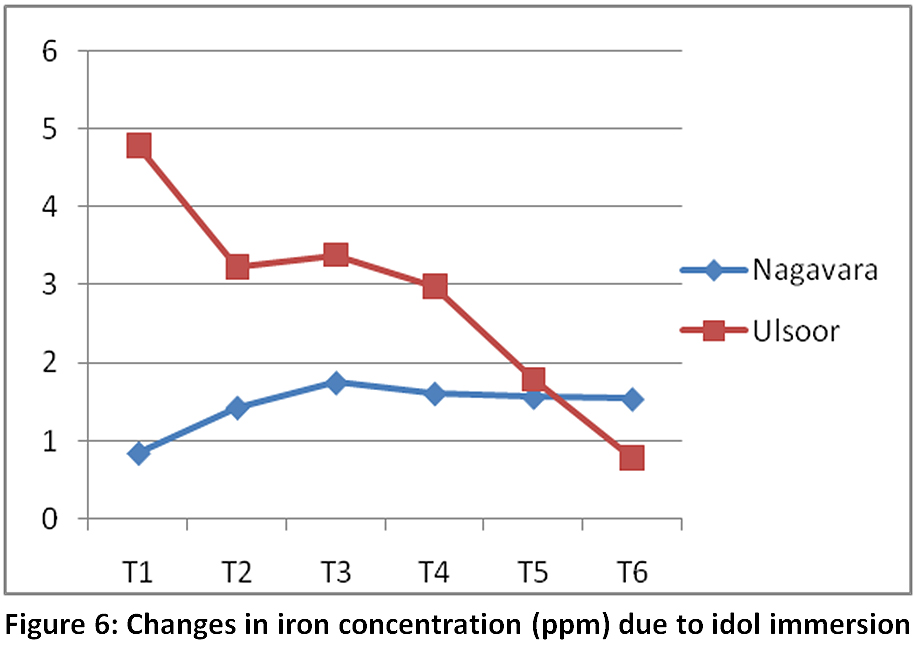 |
Figure 6: Changes in iron concentration (ppm) due to idol immersion Click here to view Figure |
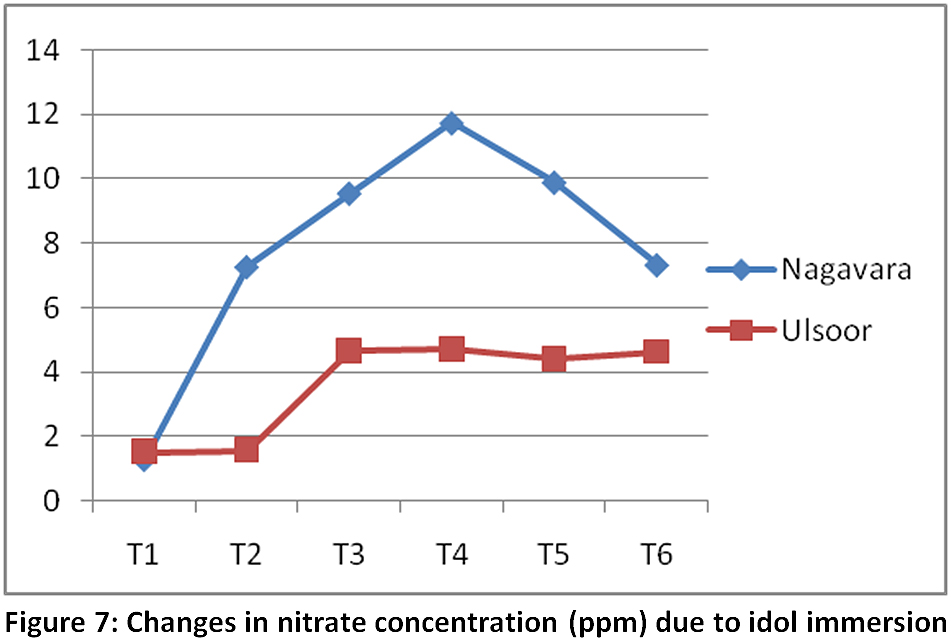 |
Figure 7: Changes in nitrate concentration (ppm) due to idol immersion Click here to view Figure |
Fluctuation in biochemical properties of lake waters due to idol immersion activities
The Biochemical Oxygen Demand (BOD) of Ulsoor lake water, in the pre-immersion period, was 12.3 mgL-1 which after one week of immersion was recorded to be 21.5 mgL-1 (Fig. 8). However, with time the BOD again decreased to13.9 mgL-1. The COD of Ulsoor lake showed a steep increase from 118.5 mgL-1 in the pre-immersion period to 190.7 mgL-1in the post-immersion period (Fig. 9). The fluctuation in BOD of the lake water might be attributed to the dilution of biodegradable organic matter in the large volume of lake water. The immersion of painted idols in the lake waters was accompanied by the addition of leaves, flowers and other organic materials used during the rituals. These materials upon decomposition increase the BOD and COD levels creating hypoxic conditions in the system.
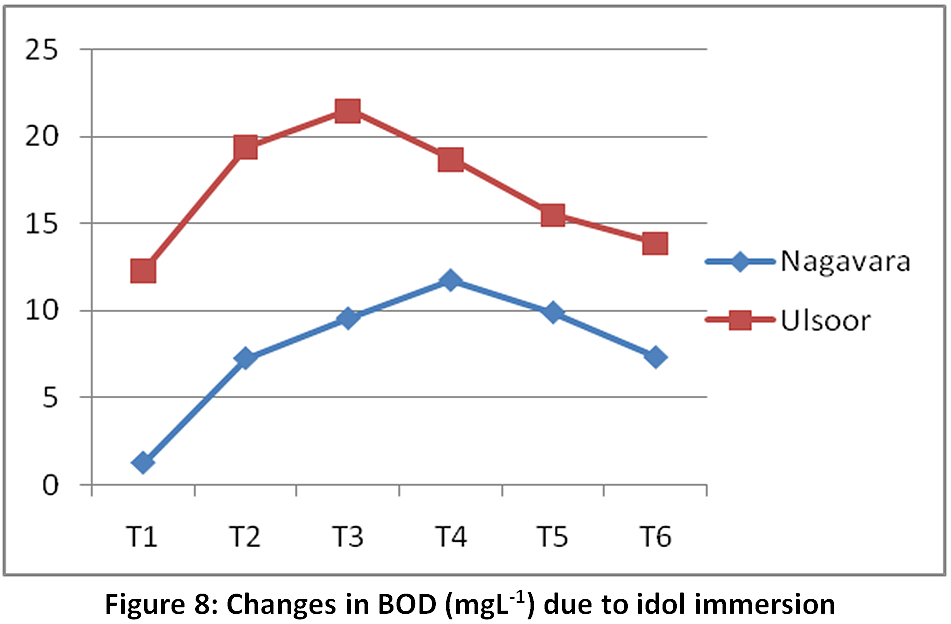 |
Figure 8: Changes in BOD (mgL-1) due to idol immersion Click here to view Figure |
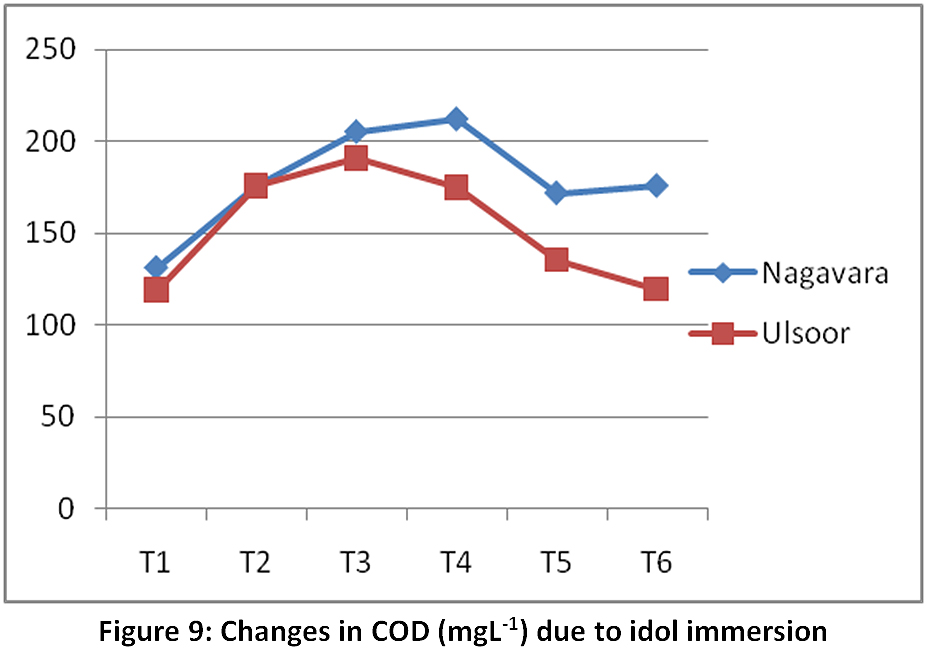 |
Figure 9: Changes in COD (mgL-1) due to idol immersion Click here to view Figure |
Conclusions
The contamination in Nagavara and Ulsoor lakes through industrial, domestic effluents as well as religious activities like idol immersion is creating an uncongenial aquatic environment through water quality deterioration. The increase in BOD and COD levels in the lake water during the course of study reflect significant addition of biodegradable organic matter due to the idol immersion activities. The concentrations of heavy metals (e.g.Fe, Cr, Cd and Pb) in the lake water increased in the post-immersion period. Since, heavy metals contamination is detrimental to animal system seven at very low concentration, public awareness regarding this problem should be generated.
Acknowledgements
The authors are thankful to the University of Agricultural Sciences, Bengaluru and Indian Council of Agricultural Research, New Delhi for providing the research infrastructure and financial support respectively.
References
- Karnataka State Pollution Control Board – Research and Development Wing Publication (2001); Monitoring and Analysis of Tanks and Lakes of Bangalore; KSPCB Publication.
- Jumbe A.S., Nandini N., Tandon S. Bangalore Lakes – Issues and perspectives on pollution, restoration and management. Proceedings of Taal 2007, The 12th World Lake Conference 2008; pp 1699-1706.
- Clark C.S., Rampal K.G., Thuppil V., Chen C.K., Clark R. and Roda S. The lead content of currently available new residential paint in several Asian countries. Environmental Research 2006;102: 9- 12.
CrossRef - Kumar A., and Pastore P. Lead and cadmium in soft plastic toys. Current Science 2007;93(6): 818-822.
- Kumar A. Brush with Toxics- An investigation on Lead in Household Paints in India. Toxics Link Publication, New Delhi 2007; pp. 1-36.
- Johnson S., Saikia N., and Sahu R. Centre for Sustainable Environment, Project Report, New Delhi; 2009.
- Desai J., and Tank S.K. Deterioration of water quality due to the immersion of Ganesh idols in the river Tapti at Surat (India). Journal of Environmental Research and Development. 2010;4(4): 999-1007.
- Bubicz M. Heavy metal in the aquatic environment of some water bodies of the Lublin basin. Aquatic Hydrobiology 1982; 24: 125-138.
- Lokeshwari H., and Chandrappa G.T. Impact of heavy metal contamination of Bellandur lake on soil and cultivated vegetation. Current Science 2006;91(5): 622-627.
- Anonymous, Standard Methods for Examinations of Water and Waste Water. American Public Health Association, Washington, D.C., 14thEdn, 1975; pp 1-624.
- Anonymous, Standard Methods for Examinations of Water and Waste Water. American Public Health Association, Washington, D.C., 19th Edition1995; pp 1-541.
- Manivasakam N. Physico-Chemical Examination of Water, Sewage and Industrial Effluent. Pragathi Prakashan Publication, Meerut, India 1987; pp 1-268.
- Gorain B., Parama V.R.R., and Paul S. Impact of Idol Immersion Activities on the Water Quality ofHebbal and Bellandur Lakes of Bengaluru in Karnataka, Journal of Soil Salinity and Water Quality 2018;10(1):112-117.
- Reddy V.M., and Kumar V.A. Effect of Ganesh idol Immersion on some water quality parameters of Hussain Sagar. Current Science 2001; 18: 1412.
- Ujjania N.C and Multani A.A. Impact of Ganesh idol immersion activities on the water quality of Tapi river, Surat (Gujarat) India. Research Journal of Biology 2011;1(1): 11-15.
- Mehta P. Alteration in water quality parameters and consequential impacts due to festival waste in Jodhpur. International Journal of Science and Technology 2013;17(1): 1166-1176.
- Kaur R. Effect of idol immersion on marine and fresh water-bodies. Advances in Applied Science Research 2012;3(4):1905-1909.
- Das K.K., Panigrahi T., and Panda R.B. Idol immersion activities cause heavy metal contamination in riverBudhabalanga, Balasore, Odisha, India. International Journal of Modern Environmental Research 2012;2(6): 4540-4542.
- Gorain B., Parama V.R., and Paul S. Heavy Metals Contamination in Madiwala and Lalbagh Lakes of Bengaluru, Karnataka: Effect of Idol Immersion Activities. Int.J.Curr.Microbiol.App.Sci.2018;7(10): 2254-2263. doi: https://doi.org/10.20546/ijcmas.2018.710.260
CrossRef






